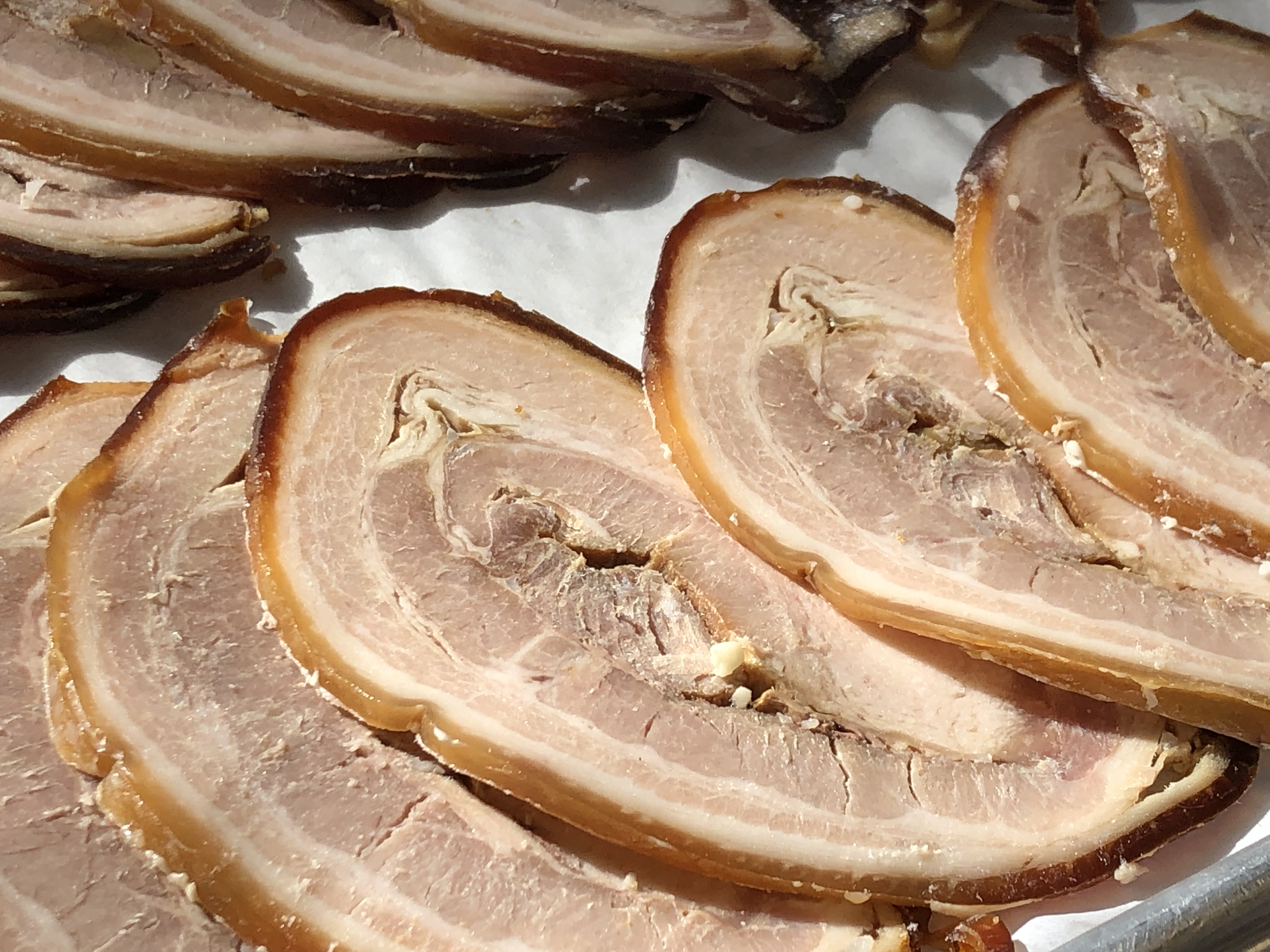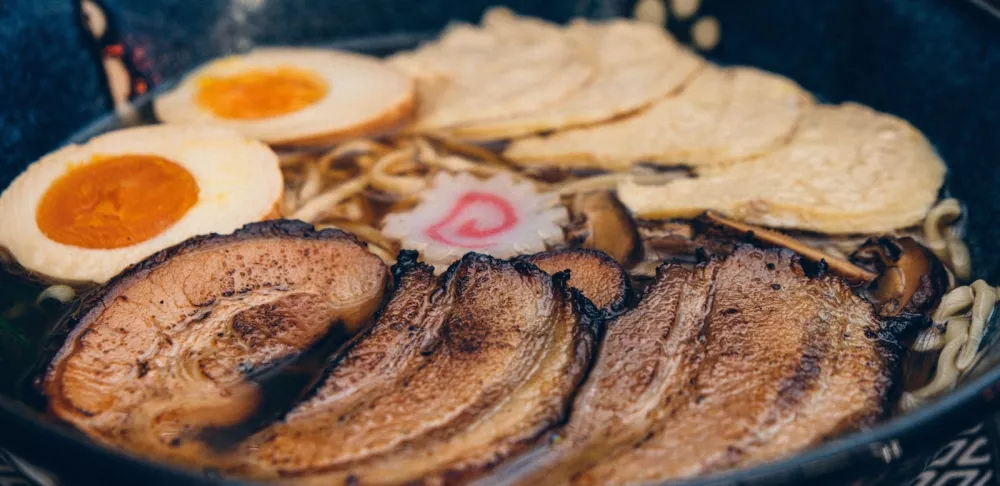Celebrated as Japan's ultimate comfort food, ramen has become a global culinary sensation with its hallmark chewy noodles, tantalizing toppings and steaming soup. Yet, the true essence of this beloved dish lies in its diverse broths.
Vastly different from the vaguely chicken-flavored powder found in its popular instant form, traditional Japanese ramen broth has a full spectrum of different flavors to experience, depending on your pick from the menu.
Shoyu (Soy Sauce) Ramen
Originating in the bustling metropolis of Tokyo, shoyu ramen epitomizes the fusion of simplicity and sophistication. Its clear, umami-rich broth is delicately seasoned with soy sauce, creating a harmonious blend of flavors. Crafting this elegant base is a meticulous process that involves simmering a combination of chicken and pork bones. Although not traditional, minor ingredients such as ginger root, scallions or garlic can be added to this stock. Once the stock is simmered and strained of impurities, soy sauce is added to achieve a savory and aromatic profile. Although simple, this Japanese ramen broth carries the show with its caramel-colored hue and earthy saltiness.
Shoyu ramen often includes tender slices of chashu (braised pork belly), menma (fermented bamboo shoots), finely chopped scallions and classic nori (seaweed). An optional marinated soft-boiled egg adds a creamy contrast to the savory ensemble. To upgrade this already savory bowl, the egg can often be marinated in its rich soy sauce broth a day or two before, leaving it with a lightly tanned exterior to blend in with this delicious noodle soup.
Up Your Ramen Game with a Soy Egg
Shio (Salt) Ramen
In the heart of Hokkaido, shio ramen stands as another testament to the art of subtlety. This refreshing ramen variety boasts a clear, salt-seasoned broth that allows the essence of the sea to shine with utmost clarity. The broth begins with either chicken or pork bones, chosen for their mild and complementary flavors. High-quality sea salt is added delicately, allowing the natural saltiness to take center stage without becoming overpowering. Achieving pristine clarity is a result of a gentle simmer, meticulous skimming and precise straining. If the stock is agitated too frequently during straining, the impurities often blend in, causing the crystal-clear soup to become murky in the aftermath. The gentle, transparent coloring of this ramen noodle soup matches the refreshingly smooth flavor of shio.
The toppings for shio ramen are thoughtfully selected, often featuring crisp bean sprouts, wakame (seaweed), slices of kamaboko (fish cake) and a sprinkle of minced scallions. This minimalist approach allows the subtle saltiness of the broth to remain the main character.
Miso Ramen
Also hailing from Hokkaido, miso ramen offers a departure from the transparent broths, diving into a world of robust, cloudy umami. Crafting this bold flavor profile entails the use of fermented soybean paste, or miso, which imparts an earthy, rich depth to the broth. The broth is prepared by simmering pork or chicken bones, with a seasoned miso paste added to create a thick, flavorful base. This miso paste is often several types of miso blended together to the perfect balance, meaning that every ramen shop will have its own unique miso paste that can offer differentiating undertones. Using more red miso paste, for example, may give it a more earthy, hearty flavor; yellow miso may give a more pungent, fermented flavor.

Miso ramen toppings often include buttered corn, slices of chashu, marinated eggs, bean sprouts and mayu (pungent black garlic oil), all coming together beautifully with the rich broth. Unlike shio and shoyu, which give more attention to the broth, miso ramen has no problem drowning many of the common ramen toppings in its flavor.
Tonkotsu Ramen
Venture to Fukuoka, and tonkotsu ramen, renowned for its creamy, milky-white broth, reigns supreme. The secret behind its lush consistency is the meticulous process of simmering pork bones for an extended period, extracting every ounce of flavor and creaminess from the bones. The result is a broth that's rich, hearty and almost velvety in texture.
The journey to crafting tonkotsu broth is an enduring one, with bones simmered for up to 16 hours — sometimes even longer. This extended cooking time allows the collagen-rich marrow and connective tissues in the pork bones to break down and dissolve into the broth, creating a thick and luscious consistency. This beautifully golden-colored stock will often become a thick, jiggly block of aspic once chilled. This is usually a hallmark sign of a perfectly made tonkotsu stock, ready to be heated and poured over a bowl of bouncy, chewy ramen noodles.
Related:Types of Japanese Noodles
Just like miso ramen, traditional toppings are often paired with tonkotsu ramen, including slices of chashu, black garlic oil, finely chopped scallions and pickled ginger, all complementing the rich broth. These heavy ramen broths don’t need to worry about toppings stealing the show.
Tantanmen (Sesame-Based) Ramen
Tantanmen, while not native to Japan, has found its place in the country's ramen culture. This spicy and creamy broth draws inspiration from Sichuan cuisine, resulting in a fiery culinary adventure that carries a touch of its Chinese heritage. Tantanmen's origins trace back to the Sichuan province of China, where the dish is known as dan dan noodles. In its traditional Chinese form, this dish features a rich and spicy sauce made from ground Sichuan peppercorns, chile oil, sesame paste and minced pork. The heat and complexity of Sichuan flavors shine through, providing a robust, fiery and aromatic dressing for the noodles.
In the Japanese adaptation of tantanmen, the essence of the Sichuan sauce is preserved. A base of sesame paste forms the heart of the broth, lending a creamy texture and nutty flavor.
By adding soy milk to this paste, it becomes a much milder version of this fiery dish; while also turning it into a lovely, creamy soup instead of a heavy, saucy meal. Chile oil, Sichuan peppercorns and various spices are incorporated to create a spicy and aromatic profile. Ground pork is traditionally browned and added to enhance the broth's depth.
Toppings often include wilted spinach, bean sprouts, sesame seeds and a numbingly spicy chile paste, allowing diners to customize their spice level, reflecting the Chinese roots of the dish.
Tsukemen (Dipping Ramen)
In Tokyo, Tsukemen reimagines the traditional ramen experience by separating the noodles and broth. The concentrated broth is achieved by simmering a blend of chicken and pork bones and flavored with aromatic ingredients. Unlike the previously explained ramen broths, this soup is reduced until heavily concentrated and then strained. The result is a broth that's bold and intensely flavored, that it’s enjoyed not actually as a soup, but by lightly dipping chilled or heated noodles into this concentrated broth, allowing the flavor to lightly cling to the noodles.
Tsukemen toppings often feature sliced chashu, nori, menma and marinated soft-boiled eggs. The noodles themselves are thicker and chewier than traditional ramen noodles, creating a delightful contrast in texture when compared to traditional Japanese ramen dishes. These large noodles also help the deeply flavored dipping broth stick to more surface area, without letting the broth overwhelm the dish.
Kaisen Ramen (Seafood-based)
From the coastal regions of Japan emerges kaisen ramen, a tribute to the sea's bounty. This ramen variety features a light broth primarily crafted from an array of seafood ingredients such as fish, shrimp, clams and scallops, and lightly seasoned with soy sauce or miso. The seafood ingredients infuse the broth with a refreshing and briny essence, making it a delightful symphony of the sea’s bold flavors with a gentle contrast of salt or earthiness.
Toppings often include seafood such as shrimp, mussels, squid and bonito flakes (dried fish flakes), as well as crisp seaweed, green onions and yuzu zest, adding a refreshing twist to an otherwise fishy ensemble.
Hiyashi Chuka (Cold Noodle Ramen)
When summer approaches, hiyashi chuka emerges from Tokyo as a delightful cold noodle dish. Thin wheat noodles are chilled and dressed in a sweet and tangy sauce made from soy sauce, rice vinegar, sesame oil and sugar. This dish is then topped with pops of color from julienned cucumbers, carrots, bell peppers, thinly sliced omelet and ham. Sometimes sweet crab meat adorns the noodles, creating a refreshing and visually appealing dish.
Unlike the previous Japanese ramen types, this ramen dish is more akin to a noodle salad than a soup. The zesty dressing combined with the chilled noodles offers a uniquely light and easy-going meal compared to the usually hefty soups.
In the world of Japanese cuisine, ramen stands as a true testament to culinary artistry, offering a diverse array of flavors, textures and regional influences. From the streets of Tokyo to the coastal regions of Japan, each ramen variety presents a unique journey for the palate, showcasing the meticulous craftsmanship that goes into crafting the perfect bowl.
Need more ramen in your life? Meet Rasheeda Purdie, an ICE alumna with an acclaimed NYC ramen pop-up





